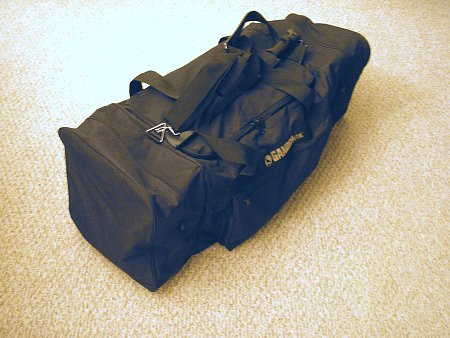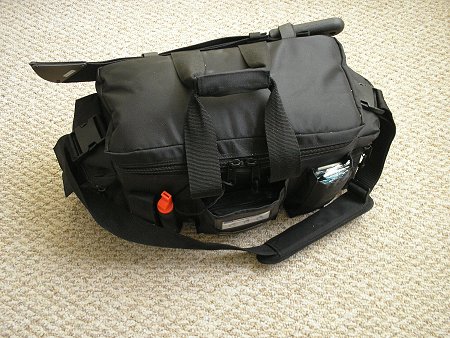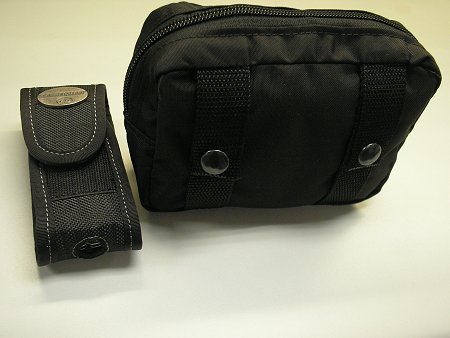its paid sponsors, whose products you need!
| Home |
| Intro |
| Current Issue |
|
Mailing List |
| Store |
| Strength |
| Subscriber Content |
| ARCHIVES
|
| Martialism |
| Pacifism |
| Q & A |
| Cunning-Hammery |
| Advertise With Us |
| Submit An Article |
| Staff |
| Discussion Forum |
| Links |
“Stay ‘unreasonable.’ If you
don’t like the solutions [available to you], come up with your
own.”
Dan Webre
The Martialist does not
constitute legal advice. It is for ENTERTAINMENT
PURPOSES ONLY.
Copyright © Phil Elmore,
all rights
reserved.
Survival Kits for Home, Bugging Out, and Daily Carry
By Phil Elmore
In late May of 2006, various news outlets reported
that the Northeast Coast wasn’t “ready for hurricane season.” A Fox
News article stated that “New York City, Long Island, and the New
England coast have all been pounded by ferocious hurricanes in years
past — and as the 2006 season shapes up meteorologists are concerned
that the Northeast is ripe for a storm that could rival Katrina, at
least in terms of property damage.” We have apparently reached the peak
of the Atlantic Ocean’s cycle of hurricane activity (a cycle that takes
a “few decades,” the news articles tell us) and dire pronouncements
about what could or might occur are being fed into teleprompters faster
than the nation’s news anchors can intone them.
Media sensationalism aside, the threat of natural
disaster is always real — because earthquakes, hurricanes, severe
snowstorms, and other phenomena don’t go away simply because we’d be
terribly inconvenienced by their intrusions into our modern lifestyles.
I remember only too well the severe blackout that occurred in the
summer of 2003, when millions of people in Canada and the Northeast
United States lost power as some sort of cascading failure made its way
through the grid (a failure we in America were quick to blame on
Canada, if I recall correctly). At the time, the first thing we all
thought was that some sort of terrorist attack had taken place. I only
started to think that after I turned on the car radio and the local AM
station — running on generator power — explained just how widespread
was the outage. Then I got worried. I got more worried when I tried to reach my wife and couldn’t get a signal on my wireless phone.
Everything worked out for the best. The power outage
was a utility failure, not a terrorist attack. The wireless phone
network was overburdened with calls, not crashed by malicious action.
While our power was out for a while, it wasn’t out as long as it was
during what we in Central New York called “The Labor Day Storm,” when
it took several days to restore our electricity. It was after that
storm that I started compiling the Big Red Box of Power Outage
supplies. Still, after the Northeast blackout of 2003, I found myself
wondering what I would do and how I could plan for future natural
emergencies — and for civil unrest. Was I prepared enough?
In the course of my life I’ve watched plenty of
dramas unfold in different parts of the country — disasters like
fires, riots, and other “acts of God” and humanity that always seemed
very distant to me. For whatever reason, the lurid yellow journalism
that flowed from countless poison pens in the aftermath of Hurricane
Katrina affected me in ways those other disasters never did. I watched
with horror as breathless reporters regaled America with what we now
know were exaggerated and even fabricated tales of rape, looting, and
tragedy in New Orleans and elsewhere. I found myself picturing
something similar happening where I lived. How could I look my loved
ones in the eye and tell them I wasn’t ready, that I couldn’t be
bothered to do anything ahead of time?
The time to prepare for emergencies is before the fact. “Survivalism” is one facet of martialism. It is, at its core, preparedness
— taking the time to plan ahead, to stockpile necessary items, to
envision and (if necessary) to apply problem solving skills to
unforseen adverse conditions. To be a martialist, you must be a
survivalist. To be a responsible human being living in uncertain times,
you must be a survivalist. To be a survivalist, you must assemble a
survival kit.
There are countless approaches to creating a survival
kit and there are really multiple kits a given martialist might choose
to create. My survival kits are always evolving as I find new, useful
gear and replace old, obsolete, or redundant items. As I spent a few
early mornings watching Hurricane Katrina news coverage and surfing
survival sites, I formulated a plan that I followed slowly over the
course of the year that followed. I did not need a single survival kit.
I needed three.
Specifically, I needed a large kit for home —
something that would contain everything I could think of stowing for
use in future emergencies. (The home kit is, by definition, something
that does not leave the home.) I needed a bug-out kit, too, something
that could be relatively large and heavy but had to be mobile. It had
to be something I could grab while leaving the home, something I could
easily put in a vehicle and take with me. Finally, I needed a personal
survival kit, something to augment the daily carry items I already
toted. I had in my head, as I planned the kit, visions of September 11,
2001. I remembered the commuters who worked in New York city, making
their way on foot out of Manhattan with only the supplies they carried
with them to sustain them. To that end, I planned a survival shoulder
bag that would become my constant companion as I commuted to and from
(and traveled for) work.
Before we discuss the contents of the survival kits,
let us address what they do not contain: weapons. Survival weapons are
certainly important, but they are beyond the scope of these kits.
Entire books have been devoted to the topic of guns for The End Of The
World As We Know It (TEOTWAKI). Guns should be carried on your person
or stored securely in vaults or other separate locations, so we won’t
get into them here. Do not think, however, that I am dismissing them.
There’s no point in assembling survival kits of this type if you don’t
also consider weapons (as violence is frequently a side effect of
scenarios in which the veneer of civilized, modern society is torn
away). We simply won’t cover them in this article.
THE HOME KIT
The home kit is contained in a Gander Mountain duffel
bag that’s large enough to hold a human body (a small one, anyway). In
many ways it is simply a larger version of the mobile bug-out kit,
containing the same items (but more of them). For example, it contains
multiple medical kits and larger supplies of medicine (which would be
too bulky to haul around in the mobile kit). There are a few variations
in contents that should be obvious, too.

For example, the home kit contains more medical
supplies, food, and water rations because weight is not an issue. It
doesn’t contain a tent because there’s no need for a tent at home
(whereas the mobile kit does contain a small tube tent).
The home kit contains the following items:
-
MREs
-
Water rations
-
Food bars (survival rations)
-
Two 5 x 7 foot brown polyurethane tarps
-
New York and Pennsylvania Topographical Maps
-
Compass
-
Backpack for foraging
-
Bandannas
-
Waterproof matches
-
Dynamo Flashlights
-
Crank radio
-
Dynamo radio/flashlight
-
Light sticks
-
Household batteries
-
Gerber multiple LED light
-
Six 2-gallon water bags (ready for filling)
-
Canteen with potable aqua pouch
-
Potable aqua
-
Filter bottle
-
“Puck” Sharpener
-
Diamond sharpener rods
-
Prybar
-
Gerber multitool
-
Socket and driver set
-
Rope
-
Paracord
-
Knot card
-
Utility razor/li>
-
Commercial survival tin
-
Duct tape, fabric tape, electrical tape
-
sewing kit
-
Break Free CLP
-
Gun Brite polish
-
Hobo knife
-
Machete (Cold Steel)
-
Prybar
-
Heavy duty Velcro
-
Assorted nails
-
Various Nalgene bottles
-
Vinyl gloves
-
Face masks
-
Survival knife and snakebite kit
-
Metal cup
-
Stansport fold-a stove with fuel
-
Panchos
-
Survival Blankets
-
Eye drops
-
Gerber folding saw
-
Folding shovel
-
Multiple commercial first aid kits
-
Potassium Iodide
-
Sudafed
-
Benadryl/li>
-
Anti-diarrheal
-
Antibiotic ointment
-
Aspirin
-
Ibuprofen
-
Hydrogen peroxide
-
Isopropyl rubbing alcohol
-
Anti-bug sprays
-
Burn gel
-
Tick tweezers
THE BUG OUT BAG (BOB)
More important than the home kit is the mobile kit or
Bug Out Bag. The concept is one with which survivalists and like-minded
readers will be familiar. It’s a prepacked, ready-to-go bag that can
travel with the citizen as he or she flees an area that has gotten to
“hot.” When the “balloon goes up,” my Bug Out Bag is waiting for me to
grab it. No thought has to go into this, other than remembering to grab
the bag and put it in my car. (The bag could also be carried, but it is
not light enough for daily toting).

Into the bag goes everything that two people might
need to get them through everything from a minor emergency to civil
unrest and all-out societal collapse — the caveat being that the bag’s
contents are to get you where you are going, not sustain you
indefinitely in the field.
The Bug Out Bag contains the following items:
-
Cash
-
Compass
-
Maps
-
One 5 x 7 foot tarp
-
Tube tent
-
Potable Aqua
-
Filter canteen
-
Filter straw
-
Two 2-gallon water bags (ready to fill)
-
Whistle/compass/match holder
-
Humvee tool with LED flashlight
-
Portable chainsaw
-
Hand shovel
-
4-in-1 Hammer/Prybar/Gas/Water shutoff tool/li>
-
Carabiners
-
Can opener
-
Wire saw
-
Signal mirror
-
Umbrella
-
survival knife
-
small locking cable, lock
-
Fishling line and hooks/fishing kit
-
Light load towels
-
Dust masks
-
Gerber Multitool
-
Small pocketknife
-
Hobo knife
-
Camillus marlinspike knife
-
Gun Brite polish
-
Break Free CLP
-
Facial tissues/toilet paper
-
Electrical tape, duct tape
-
Sewing kit
-
Grappling hook, rope
-
Krazy glue
-
Allen wrench tool
-
Work gloves
-
Knots guide
-
Sling shot, spare sling, ammo
-
Sharpie marker
-
Pen
-
Pocket-its utiltity pouch
-
Panga machete (Cold Steel)
-
Deck of cards
-
Disposable Panchos
-
Emergency Blankets
-
Waterproof matches
-
Magnesium firestarter
-
Sparklite Kit
-
Light sticks
-
Butane lighter
-
Survival Candles
-
Paracord
-
Utility cord
-
US Army Survival Manual
-
Full travel medical kit
-
Supplemental first aid and burn gel
-
Tick tweezers
-
Antibiotic ointment
-
Anti-bug spray
-
Potassium iodide
-
Benadryl
-
Dramanine
-
Ear plugs
-
Eye drops
-
Antibacterial wipes
-
Snakebite kit
-
Small “Axe” spray
-
2400 calorie bar
-
Aqua boxes
-
Bandannas
-
Kefiyah
THE JACK SACK
The third and final component of my survival kits is
my daily carry shoulder bag. This is a Rothco Messenger Bag that I
purchased specifically because it is similar (if not identical) to the
one carried by “Jack Bauer” on the Fox series 24. I call it, affectionately, the Jack Sack.
It happens to be a really great bag, too. It is of heavy Olive Drab
canvas, made in India, largely open inside with several side pouches.
It has one large flap that closes using hook and loop strips, keeping
the contents reasonably secure but allowing easy access to the interior
of the bag.

The wide shoulder strap is absolutely necessary
because I need to be able to sling this bag and carry it with me,
possibly hands-free. My Jack Sack is also full to capacity; it cannot
hold much more or it would be too heavy to tote. As it is, a person
smaller than me would find it uncomfortable to sling this sack for any
length of time. You must tailor the contents of your daily carry bag to
suit your individual needs.
Jack sack contains these items:
-
A rigid plastic organizer for files, books, and papers
-
Personal items, memory sticks, and other odds and ends for work
-
My PDA, charger, and USB cable
-
First aid kit with snakebite kit, earplugs, etc.
-
Spec Ops On Board Dry Cell Organizer and Wingnut Travel Organizer
-
Signal mirror
-
Paracord
-
Compass/Whistle/Thermometer/Magnifier Survival Tool
-
Fishing kit
-
Sparklite kit/li>
-
Purifier straw
-
Pocket razor blade
-
Krazy glue
-
Batteries
-
Countycomm.com AM/FM/SW radio
-
Leather gloves
-
Space blanket
-
Disposable pancho
-
Umbrella
-
Pocket LED light
-
Kleenex
-
“Off” anti-bug spray
-
Hobo knife
-
Pens
-
River Rock LED light
-
Brinkmann Maxfire
-
Eyeglass kits
-
Eyeglass straps
-
Eyedrops
-
Titanium escape card
-
Torx and screwdriver kits
-
Pocket duct tape
-
Break Free CLP
-
Waterproof matches
-
Antbacterial wipes
-
PAL light as beacon
-
Boonie hat
-
Victorinox survival kit (with compass, etc.)
-
Moleskine notebook
-
Toothbrush and toothpaste
-
Kefiyah
-
Bandanna
-
Butane lighter
-
Small folding hacksaw
-
Victorinox multitool
-
Locking folding knife (selected for its flat profile)
-
Diamond sharpening rod in pen-cap case
-
Nail clippers
-
2AA Flashlight with LED conversion and tailcap kit
-
Sewing kit
-
Small Swiss Army Knife
-
Potassium Iodide tablets
-
Nukealert alarm
-
A copy of The 2 Oz. Backpacker: A Problem Solving Manual for Use in the Wilds
-
Maps
THE MINIMAL ON-BODY KIT
Using these three kits I am covered for a variety of
scenarios, including varying locations when emergencies are identified.
If I am home and plan to stay there through an emergency (a decision
you must never take lightly,
I have a complete kit, supplemented by the BOB kit if I need additional
items. If I must flee, I have the BOB kit, which I could supplement
with the items in my daily carry Jack Sack.

The author’s minimal on-body kit, with Leatherman tool.
If I am away from home and must get back to it, or
cannot reach home and must be sustained only by what I carry with me, I
have a reasonable number of supplies in the Jack Sack. The contents of
each of these three kits is a function of what I think I’ll need. This
means that your own kit contents will vary based on your needs, your
environment, your specific issues, etc. For example, if you take
certain medications, you must have a supply of them on hand. (I have
eyedrops in all my kits because I often suffer from dry eyes, and I
carry eyeglass repair kits because I wear glasses all the time. You
might have no need of such things.)
My BOB and my Jack Sack also contain books with
survival information in them. My home library contains extensive
materials on the topic. Don’t assume you can remember everything you’ll
need to know in a survival situation. Carry emergency information with
you as part of your arsenal of survival gear, because you never know
when you might need to deal with something that you can’t simply
accomplish off the top of your head.
There is one problem we’ve not yet addressed, at
least as these three kits apply to my own daily life. While I carry my
Jack Sack every day when I go to work, and when I take trips of any
significant distance, I don’t carry it when I’m out and about
relaxing. It’s more a work bag than anything else. What happens on the
weekends or when taking a simple hour drive to a relative’s house? The
need for a minimialist on-body kit — Minimum Accessories for Personal Preparedness
— is clear. While most of your minimum accessories can be carried on
your person and in your pockets, take the time to create a small kit
(as described here so you have the bare minimum necessary to live as a prepared martialist. The categories I recommend you cover are these:
-
Cash
-
Communications (a wireless phone) or CB radio
-
Light (a flashlight)
-
Fire (a lighter)
-
Water (potable aqua)
-
Tools (a multitool, ideally, or at least a knife)
-
First Aid
-
A Bandanna (the most useful single item you can carry)
-
Shelter (disposable pancho and/or emergency blanket)
-
Direction (a compass)
PREPARE NOW OR PAY LATER
Every survival kit is a work in progress. You will
discard outdated items and replace them with fresh supplies or updated
and improved technology. You will think of things to add that I have
not included here (or you will discard items I have included for which
you do not see a need). Personal taste and individual circumstance will
dictate much of what you choose to stockpile. What is important is that
you formulate a plan and act on it.
It took me several months of planning, organizing,
and obtainign supplies before I was satisfied with the arrangement of
my kits. You cannot afford to try and do all of this planning and
building when an emergency arises. The time to plan and to prepare is now, before anything goes wrong. Do not wait. Do not waste time.
Get started now.
